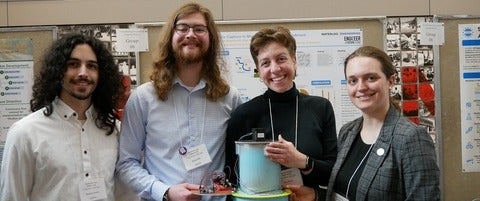Capstone Group Airsero wins $5k in Norman Esch Pitch competition with eco-friendly oil spill tech
Nanotechnology Engineering (NE) Group 26, Airsero, won several awards for their Capstone Design Project. Airsero won the $5K in an Innovation and Entrepreneurship Award at the Norman Esch Pitch Competition.
They also secured the UN Sustainable Development Goals Award within the Nanotechnology Engineering department. At the inception of their project in 2024, the team received a MITACS Accelerate Award that helped with financing the project.
Group members Anthony Keen, Aliasgar Bawangaonwala, and Hamzah Curtay knew they wanted to focus on working with aerogel materials and were eager to do a project that could lead to a start-up.
"Capstone allowed us to go beyond theory —it pushed us into actual engineering problem-solving. Our supervisor, Professor Milad Kamkar, was incredibly supportive and encouraged us to explore various facets of aerogel and material science,” said Keen.


